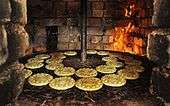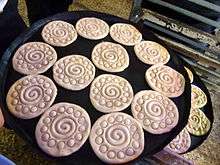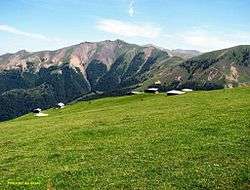Fuman, Iran
| Fuman فومن | |
|---|---|
| City | |
|
A street in Fuman, Gilan. | |
 Fuman | |
| Coordinates: 37°13′26″N 49°18′45″E / 37.22389°N 49.31250°ECoordinates: 37°13′26″N 49°18′45″E / 37.22389°N 49.31250°E | |
| Country | Iran |
| Province | Gilan |
| County | Fuman |
| Bakhsh | Central |
| Population (2016 Census) | |
| • Total | 35,841 [1] |
| Time zone | UTC+3:30 (IRST) |
| • Summer (DST) | UTC+4:30 (IRDT) |
Fuman (Persian: فومن Fuman)[lower-alpha 1] is the capital of Fuman County in Gilan Province, Iran. At to the 2006 census, its population was 27,763 in 7,728 families.[3]
Rice has been cultivated in this region for many years, where some indigenous cultivars were conventionally bred by farmers.[4] Fuman also produces popular cookies known as koluche. Fuman's koluche is thinner and larger than its brethren in Lahijan.
The city is also known for its statues, including the statue of the ancient Iranian goddess Anahita and the statue of the Four Girls.
Location
Fuman is only 27 kilometres away from Rasht, and 356 kilometres away from the national capital Tehran. Fuman is on the road to the historical city of Masuleh and as a result receives a sizeable amount of tourists.
Demographics
The inhabitants of Fuman are mainly Gilaks who speak the Gilaki language, and the Talysh people who speak the Talysh language. The majority of the inhabitants are Shia Muslims, with a minority of Sunnis present in the city.
Sports
Football is the most popular sport in Fuman, and the city is host to Shahrdari Fuman who play in the Iranian third tier.
Gallery
 Renowned thin koluche (cookies) in Fuman.
Renowned thin koluche (cookies) in Fuman. Fuman's koluche prior to being cooked.
Fuman's koluche prior to being cooked. The statue of Anahita, an ancient Iranian goddess, in Fuman.
The statue of Anahita, an ancient Iranian goddess, in Fuman. The Engineering College of Fuman belongs to the University of Tehran.
The Engineering College of Fuman belongs to the University of Tehran. Gasht is also located in Fuman County, near the city of Fuman.
Gasht is also located in Fuman County, near the city of Fuman.
References
| Wikivoyage has a travel guide for Fouman. |
- ↑ https://www.amar.org.ir/english
- ↑ Fuman, Iran can be found at GEOnet Names Server, at this link, by opening the Advanced Search box, entering "-3063110" in the "Unique Feature Id" form, and clicking on "Search Database".
- ↑ "Census of the Islamic Republic of Iran, 1385 (2006)". Islamic Republic of Iran. Archived from the original (Excel) on 2011-11-11.
- ↑ Pazuki, Arman & Sohani, Mehdi (2013). "Phenotypic evaluation of scutellum-derived calluses in 'Indica' rice cultivars" (PDF). Acta Agriculturae Slovenica. 101 (2): 239–247. doi:10.2478/acas-2013-0020. Retrieved February 2, 2014.
